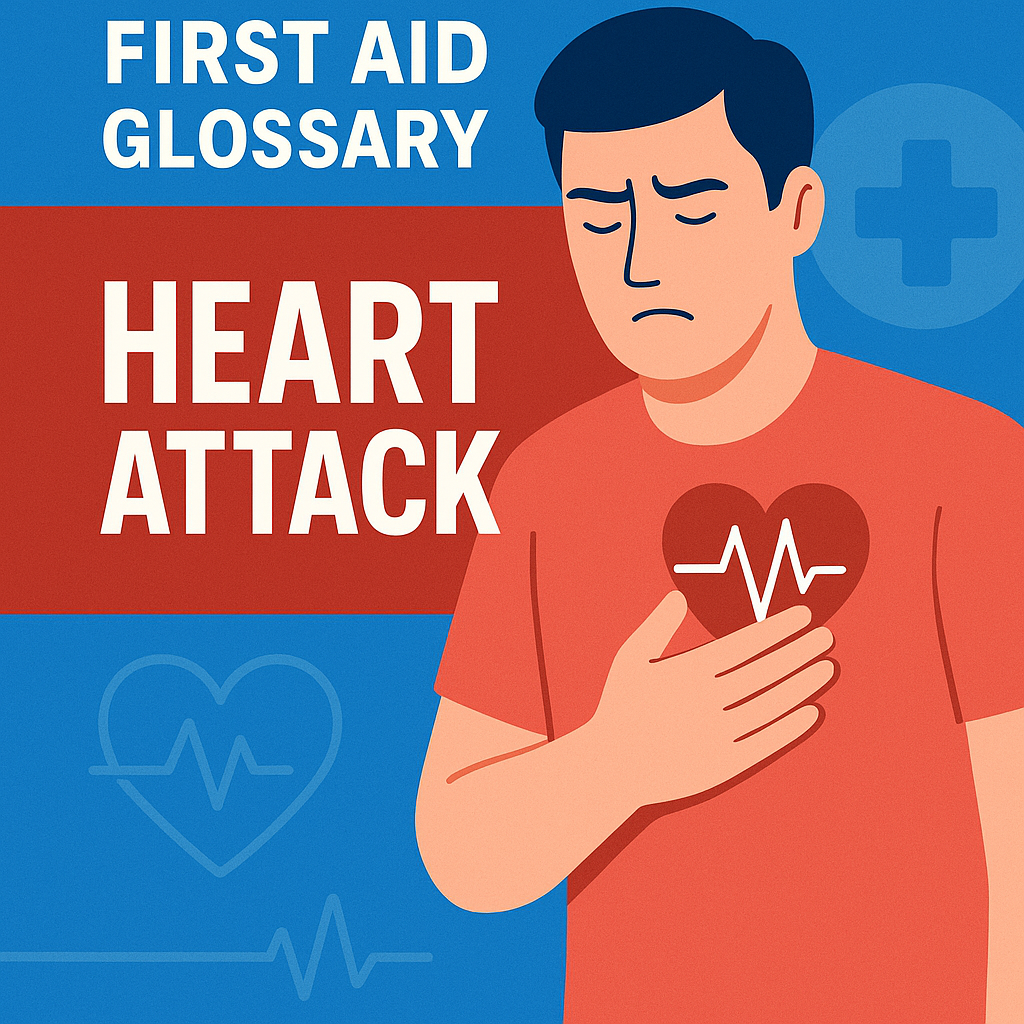- Why Knowing About Heart Attacks Matters
- Common Causes and Risk Factors
- Symptoms of a Heart Attack
- Quick Reference
- Step-by-Step Guidance for First Response
- Trainer Tips
- How Do I Know if it's Needed?
- Can It Cause Harm?
- Quick Check on Do's and Don’ts:
- Key Takeaways
- Final Motivational Note
- Related Topics
Glossary: Heart Attack Definition
A heart attack (myocardial infarction) occurs when blood flow to the heart is blocked, usually due to a blood clot in one of the coronary arteries. This disruption can damage or destroy part of the heart muscle, making quick action crucial to save a life.
Why Knowing About Heart Attacks Matters
Understanding heart attacks is essential because timely recognition and action can save lives. Think of it like knowing how to use a fire extinguisher—it’s a skill that can make all the difference in an emergency. Anyone can be a hero in these situations, so let’s dive in!
—
Common Causes and Risk Factors
![Generate a high-quality, realistic 4K image illustrating [TOPIC]. Each image should have a slightly](https://firstaidglossary.com.au/wp-content/uploads/2025/10/generate-a-high-quality-realistic-4k-image-illust-1760692565.png)
Understanding what causes heart attacks helps us recognize the scenarios that may require immediate first aid. The main culprits include:
– Coronary artery disease: Fat buildup (plaque) narrows arteries.
– Risk factors:
– Smoking
– High blood pressure
– High cholesterol
– Diabetes
– Sedentary lifestyle
– Obesity
– Family history
Imagine these risk factors as roadblocks on a highway. The more obstacles there are, the harder it is for blood to flow freely to your heart.
Symptoms of a Heart Attack
Recognizing the signs of a heart attack can be the difference between life and death. Here’s what to watch for:
1. Chest discomfort: Often described as pressure, squeezing, fullness, or pain.
2. Radiating pain: Pain that spreads to the shoulders, neck, arms, back, teeth, or jaw.
3. Shortness of breath: Can occur with or without chest discomfort.
4. Other signs: Feelings of indigestion, nausea, lightheadedness, or cold sweats.
Quick Reference
– Think of the chest pain as a warning light on the dashboard of your car—when it lights up, it’s crucial to take action!
Step-by-Step Guidance for First Response
![Generate a high-quality, realistic 4K image illustrating [TOPIC]. Each image should have a slightly](https://firstaidglossary.com.au/wp-content/uploads/2025/10/generate-a-high-quality-realistic-4k-image-illust-1760692617.png)
If you suspect someone is having a heart attack, here’s what to do:
1. Call for help immediately: Dial emergency services (000 in Australia).
2. Keep the person calm: Assure them help is on the way.
3. Positioning: Have them sit down in a comfortable position, ideally leaning slightly forward to ease pressure on the heart.
4. Check for medication: If they have prescribed nitroglycerin, assist them in taking it.
5. Monitor symptoms: Keep an eye on their condition until help arrives.
Trainer Tips
– You Can’t Make It Worse: Just like trying to fix a leaky sink; doing something is usually better than doing nothing at all.
– Stay Calm: Your calm presence can help soothe anxiety, which is a common reaction in emergencies.
How Do I Know if it’s Needed?
Recognizing the signs is the first step. If someone exhibits any combination of the symptoms mentioned, it’s better to err on the side of caution. Call emergency services immediately, as time is critical!
Remember: “Better safe than sorry” is not just a saying; it’s a lifesaving mindset.
Can It Cause Harm?
Administering first aid for a suspected heart attack, such as calling for help and keeping the person calm, is very unlikely to cause harm. In fact, standing idle while uncertain can lead to worse outcomes.
Quick Check on Do’s and Don’ts:
– Do call for help immediately.
– Don’t give the person anything to eat or drink.
– Do keep the person comfortable and calm.
– Don’t try to diagnose or treat them beyond basic first aid.
Key Takeaways
– A heart attack is a serious medical emergency that requires immediate action.
– Recognizing the symptoms and calling for help can save a life.
– Always prioritize staying calm and reassuring the person affected.
Final Motivational Note
Empowerment comes from knowledge. By understanding heart attacks and the steps to take in an emergency, you become a more confident first aider. Always be prepared, keep your first aid training up to date, and remember: every second counts. It’s not just about knowing what to do; it’s about being ready to act when it matters most.
So, take a moment to familiarize yourself with this important information, perhaps even enroll in a first aid course. The more you know, the more lives you can help save! Let’s get out there, spread awareness, and equip ourselves to be everyday heroes.
—
Related Topics
– CPR (Cardiopulmonary Resuscitation)
– Stroke Symptoms and First Aid
– Basic First Aid for Choking
Feel free to explore these related topics to enrich your understanding and preparedness!

Leave a Reply